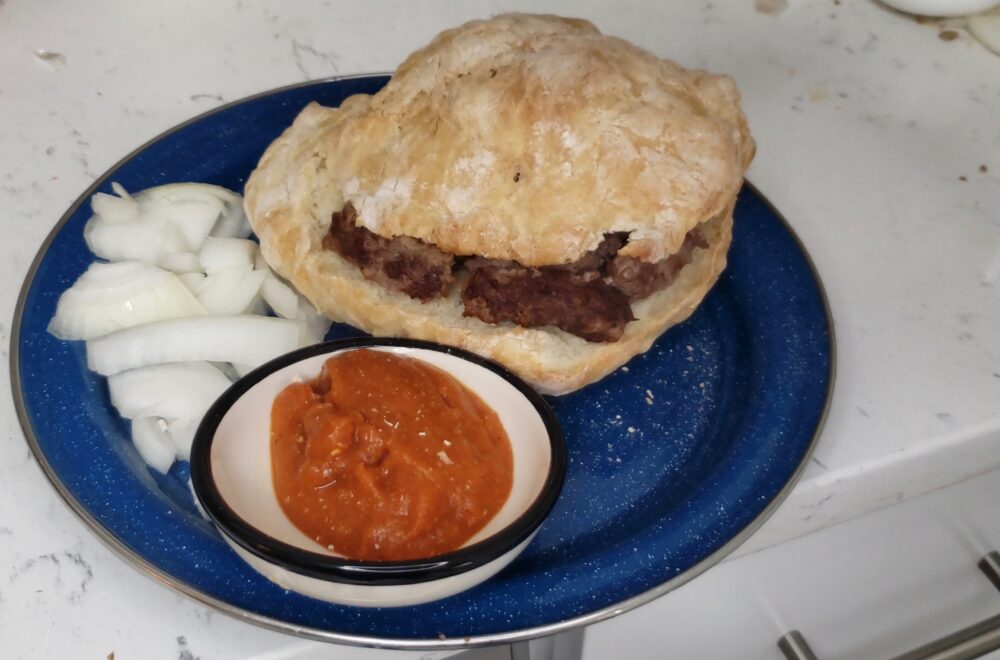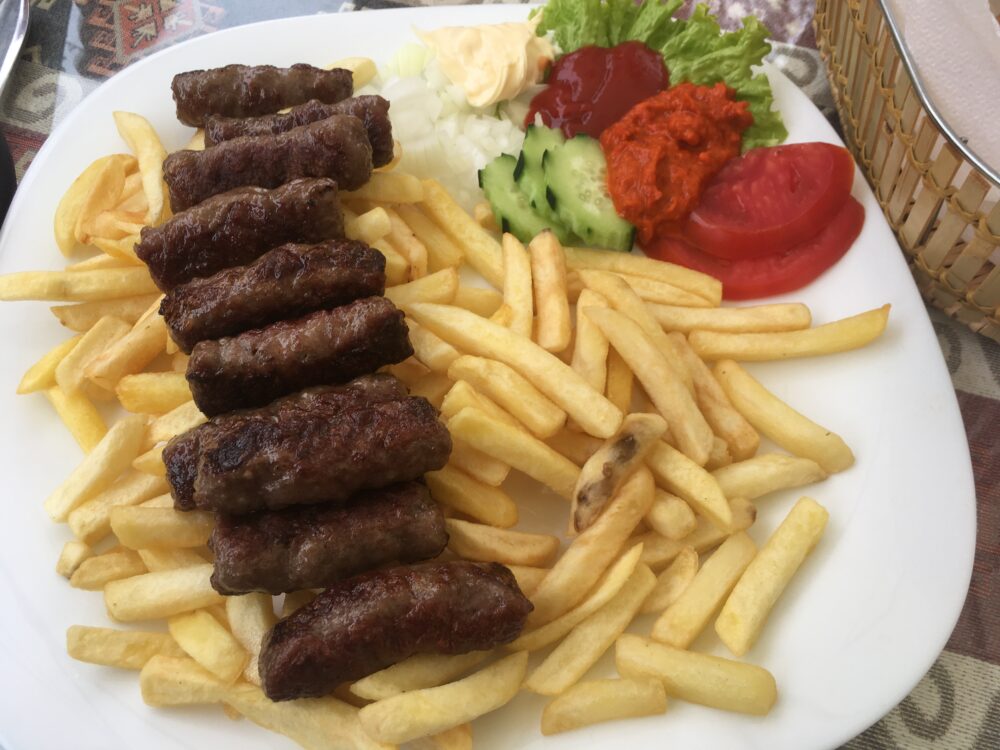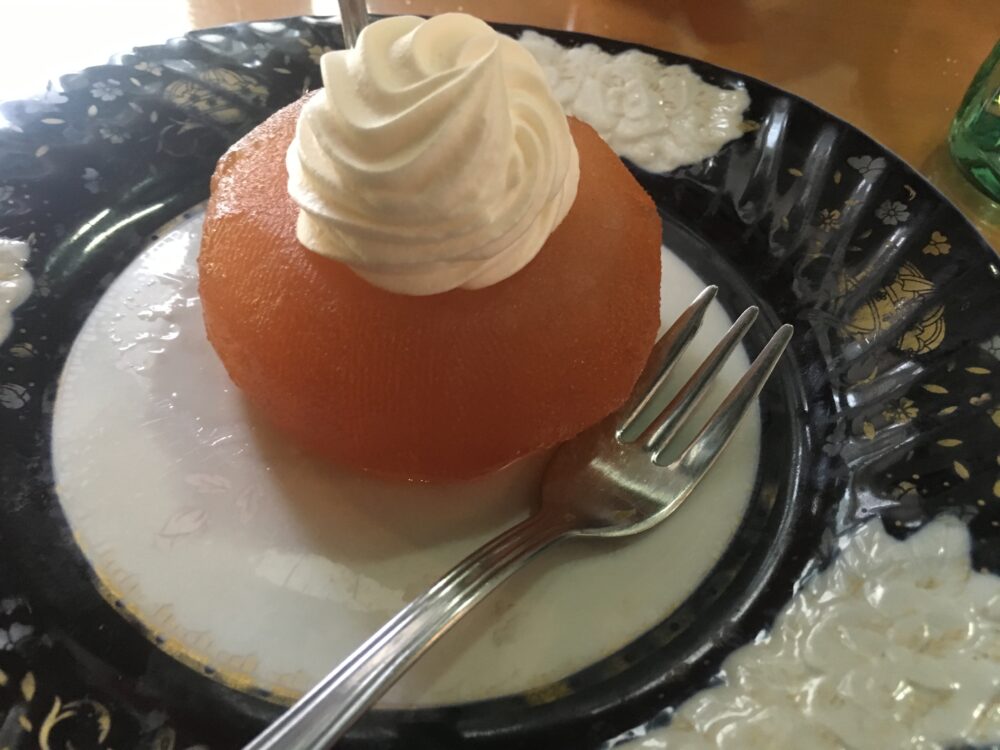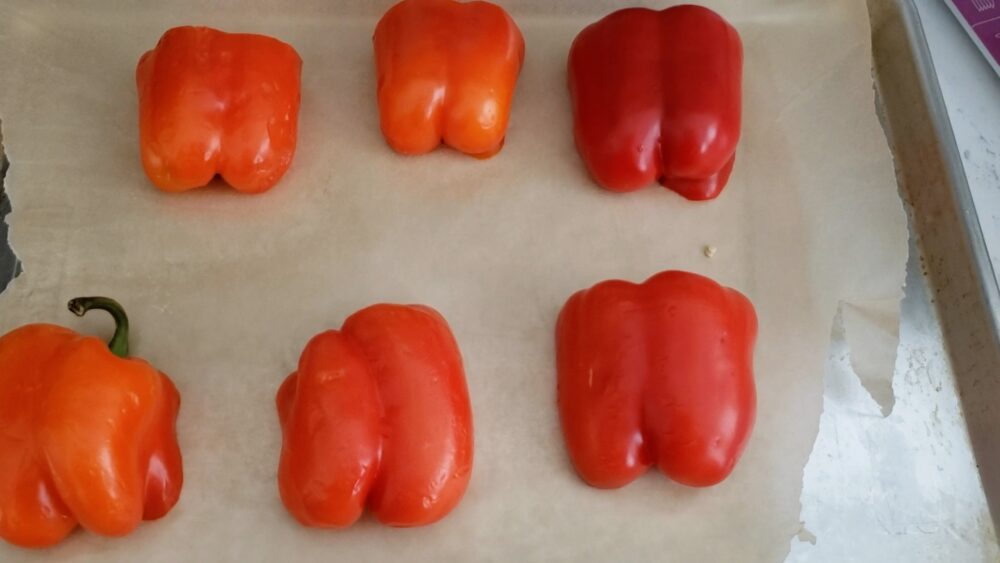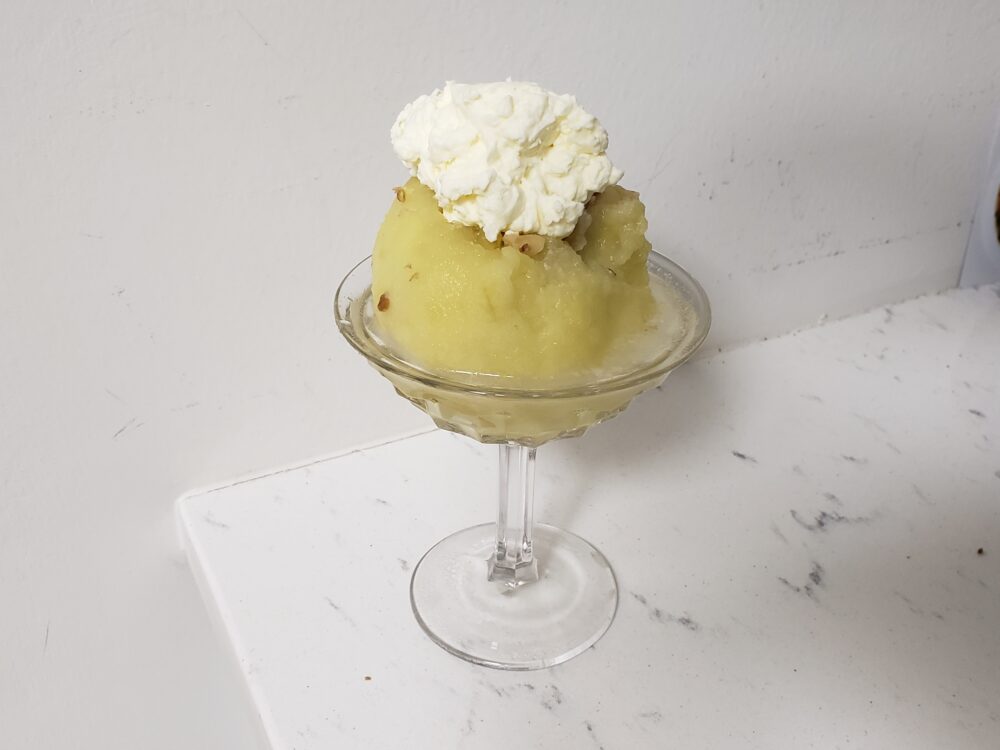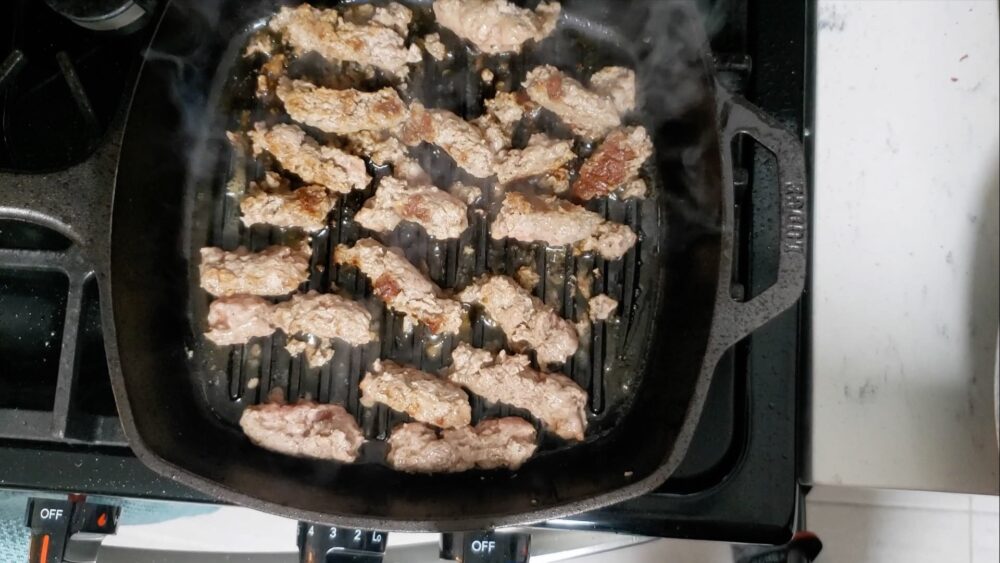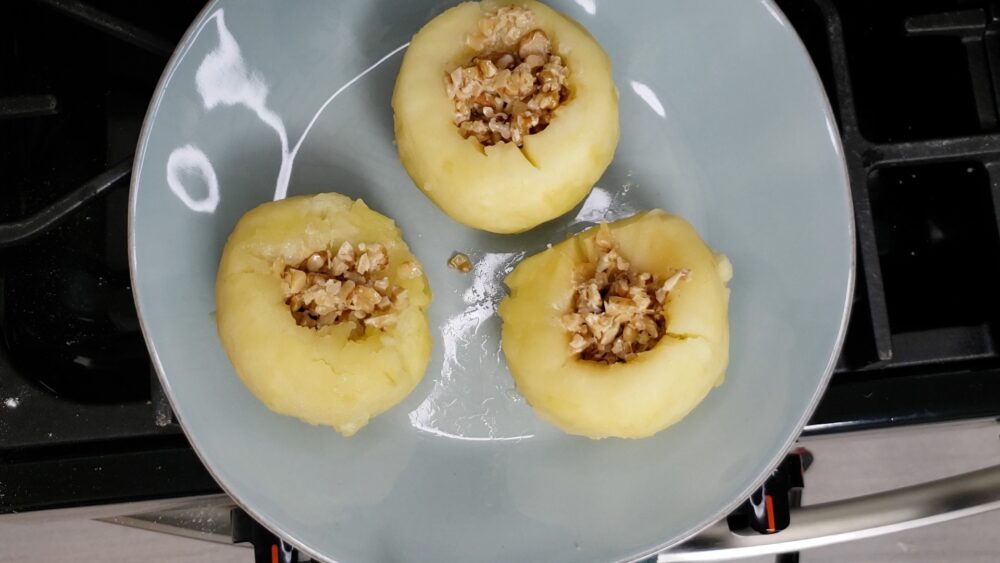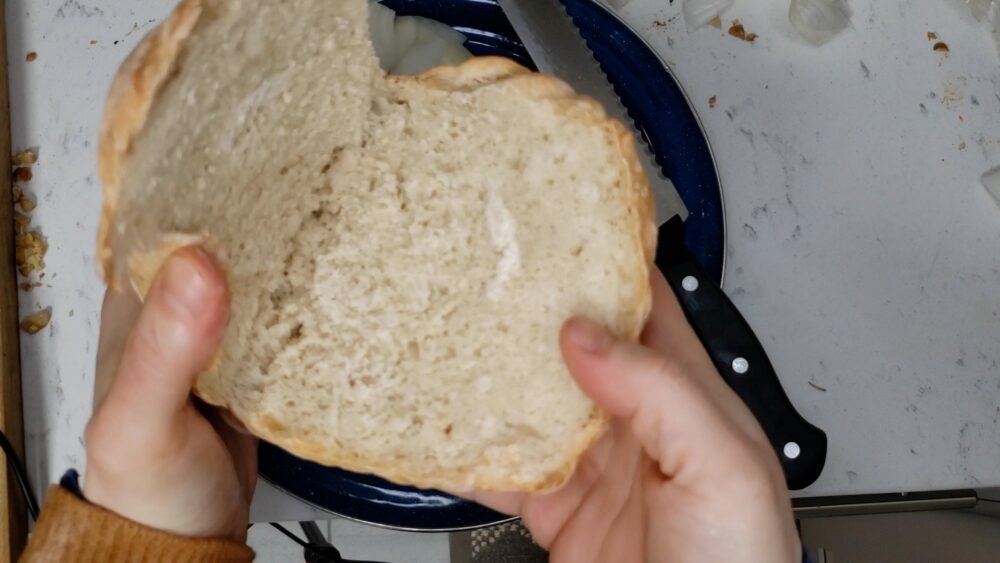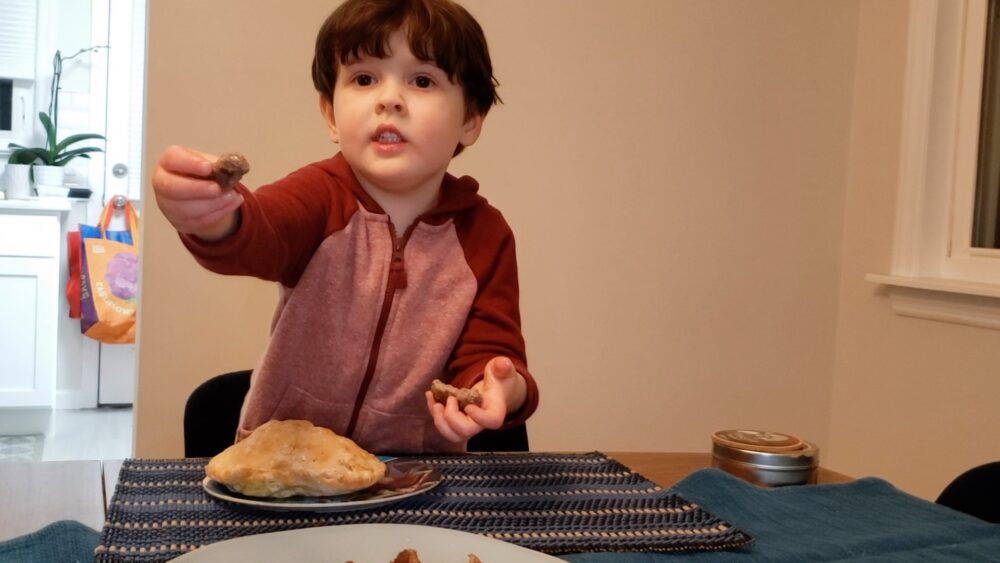Before the pandemic, Sam was on his way to having a pretty full passport. We were big travelers (and hope to be again) and Sam was lucky enough to come with us on our adventures for the first three years of his life.
The first country on our cooking journey that Sam has actually been to in real life is not the one you might expect. We took a day on our Croatian vacation a few years ago to explore a city in Bosnia and Herzegovina. And although he may not fully remember it, Sam is already a four year old expert on Bosnian cuisine.
THE CUISINE
I remember walking around the city of Mostar really feeling the combination of East and West. One side of the city felt very Mediterranean European similar to Greece and Croatia while the other side felt much more like parts of the Arabic world with heavy Turkish and Arabic influences.
So as you can imagine, the food is a strong melting pot of these different cultures and traditions.
Meat is definitely king on either side of the country with many dishes containing lamb, beef, or chicken. Pork is rarely found since a good deal of the country is Muslim. Meat is usually the main component of a meal, but seasonal local vegetables are also found regularly on the plate.
Traditional dishes are grilled, made into stews, or boiled. But sauces are very important and many are made with softened vegetables like tomatoes, peppers, spinach, and eggplant.
And you might be surprised to learn that Bosnia and Herzegovina, much like nearby Croatia and Italy, has a strong wine production. Breads and desserts are also varied and plentiful.
I know this isn’t a travel blog, but our limited time in Mostar was fascinating and delicious. Sam and I both want to go back to spend more time in the country. And working our way through their traditional dishes will be a big part of that trip.
BOSNIAN FOOD IN NEW YORK
So my very first landlord in New York was actually from this region of Europe. We weren’t terribly chummy so he didn’t give me any restaurant recommendations, but the neighborhood in Astoria where I lived had a handful of Bosnian/Serbian/Croatian restaurants.
I haven’t been to any of them in many many years, but I remember having a delicious sandwich of ćevapi at a place called Ćevabdžinica Sarajevo.
Other spots in Astoria that still serve up Balkan food, especially boureks (meat pies) and ćevapi are Ukus and Djerdan Burek.
In the East Village, there is a really wonderful restaurant called Kafana that specializes in Balkan food and serves great ćevapi. It’s a bit off the beaten path, but worth heading to Avenue C. The owners are actually Serbian, but there is a very similar cuisine to Bosnian, so if you can’t make it to Astoria or Bosnia itself, this will do in a pinch.
THE VIDEO
We decided to make our own Bosnian bread and a good deal of this video is the hijinks that ensued while Sam and I worked with yeast, flour, and our own two hands.
There is also a nice amount of reminiscing about our 2019 visit to Bosnia and you don’t want to miss Sam’s reaction to these amazing little grilled sausages. He can’t get enough of them.
THE DISHES
We might have been the most ambitious when it came to the dishes from Bosnia and Herzegovina.
Ćevapi, which is often referred to as the hamburger of the Balkans, was a must. When we were in Mostar a few years ago, we ate this dish twice. In one day!
These little skinless sausages are found all over the Balkans and are made with either beef or a combination or beef and lamb. In other countries, pork might also enter the equation but rarely in Bosnia and Herzegovina. Copious amounts of garlic, however, are always included.
Historically, they have a Turkish influence and somewhat resemble the classic Turkish kofta.
Once they are shaped by hand into small fat finger-sized orbs, they are grilled over charcoal which allows them to develop a charred smoky quality.
They are sometimes served on a bed of French fries or inside the bread we decided to make from scratch.
The bread is called Somun and it’s related to pita bread. It too was brought to Bosnia and Herzegovina via Turkey and before that probably India. It’s a soft flatbread that is made simply with water, flour, salt, and yeast. It’s a perfect vessel for the fatty ćevapi.
And then on the side, you’ll find raw onions and a special sauce known as Ajvar. This is used as a sauce, dip, or spread and is popular all over the Balkans as well. It can range from sweet to spicy.
In Bosnia, the peppers used are traditionally piquillo, but red bell peppers work also. Along with the eggplant they need to be roasted until they char before turning them into the sauce. That is to ensure a rich smoky flavor.
And then finally, because we didn’t have enough to do, we also made a dessert. This is one we tried when we were in Bosnia (see photo above). It’s rather simple but decadent and impressive.
Tufahije also has roots in the Ottoman world and its name even means “apple” in Arabic. A tart whole apple is poached in a sugar syrup and then filled with a rich buttery walnut filling. And that if that wasn’t enough, it’s topped with freshly made whipped cream. A dessert fit for a king!
THE RECIPES
Ćevapi with Ajvar and Somun from Bosnia and Herzegovina
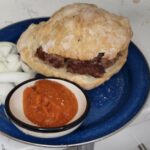
This is like the hamburger with ketchup of the Balkans. Skinless beef and lamb sausages are places into a dough pita-like bread and served with a sweet pepper sauce. It's a bit of work, but worth it for a delicious Bosnian meal.
Ćevapi (Sausages)
- 1.5 pounds ground beef
- .75 pounds ground lamb
- 3 garlic cloves (minced)
- 1 tspn black pepper
- 1 tspn salt
- 1/3 cup sparkling water
- 1/2 tspn baking soda (optional)
Somun (Bread)
- 3 tspn dry yeast
- 1 tspn salt
- 1/2 tspn sugar
- 2 cups warm water (more if necessary)
- 4 cups flour (more if necessary)
Ajvar (Red Pepper Sauce)
- 4 red bell peppers
- 1 eggplant
- 2 garlic cloves
- 2 tspn white vinegar
- olive oil
- salt and pepper
Ćevapi
-
Mix lamb, beef, garlic, black pepper, salt and saprkling water in a large bowl.
-
Knead with hands for 5 minutes until well mixed. Cover and refrigerate overnight.
-
If using, add baking soda to mixture and mix well.
-
Shape into finger sized sausages. You can use a cut open water bottle to push meat through small opening.
-
Brush grill or pan with olive oil and cook sausages on high on both sides until browned and cooked through. About 8 minutes total.
Somun
-
Mix yeast, salt, sugar, and 1 cup of warm water in a large bowl. Combine and then let rest for 10 minutes until it develops a foamy texture.
-
Add 1 more cup of warm water and 4 cups of flour.
-
Mix with hand to form a sticky dough. Cover with clear plastic wrap. Let rise for 45 minutes.
-
On a floured surface, turn dough out. Without applying too much pressure, use your fingertips to gently separate it out. Cut the dough into 4 or 5 equal pieces.
-
Using tips of your fingers, lightly form each one into a ball. Pinch the bottom to make sure there are no air pockets. Let them rise for 30 minutes.
-
On the floured surface, stretch the edges of each ball to form an oval pita shape. Be careful to not touch the center of the dough balls.
-
Add each one to a parchment lined baking sheet.
-
Preheat oven to 500° F while dough is rising again.
-
Bake for about 7-8 minutes until they puff up and brown slilghtly.
-
Take them out of the oven, cover with a kitchen towel and let sit for 5 minutes before serving.
Ajvar
-
Preheat oven to 475° F.
-
Cut eggplant into large pieces and cut peppers into halves.
-
Arrange both on separate parchment lined baking sheets.
-
Cook for about 30 minutes until they have turned somehwat black. Turn once (or more) during cooking.
-
Place them into a large bowl and allow to cool for 20 minutes.
-
When cool enough to handle, remove skin from eggplant and peel peppers. Remove core and seeds.
-
Transfer both to a blender or food processor. Add garlic cloves, white vinegar, salt and pepper. Pulse until smooth.
-
Add pureed sauce to saucepan and simmer on low for 30 minutes stirring regularly. Season with more salt and pepper if needed.
Tufahije from Bosnia and Herzegovina

This traditional apple dessert has Ottoman and Persian influences using a sweetned walnut mixture stuffed inside poached whole apples amd topped with whipped cream.
Apples
- 4 apples (tart ones, like Granny Smith)
- 1 cup water
- 1.5 cup sugar
- 1/2 lemon, juiced
- 1/4 tspn vanilla
Filling
- 1/4 cup walnuts (finely chopped)
- 1/3 cup warm milk
- 2 tbspn butter
- 1 tbspn sugar
- freshly whipped cream
Poached Apples
-
Wash, peel, and core apples. Reserve peels.
-
In a large pot, add water, sugar, lemon juice, vanilla, and the peels from one apple. Bring to boil.
-
Stir and lower to medium.
-
Add whole apples. Boil for 5-7 minutes. Flip apples to other side and boil another 5 minutes.
-
Carefully transfer apples to deep bowl and let cool for 30 minutes.
Filling
-
Mix walnuts with warm milk and set aside, covered, for 15 minutes.
-
Meanwhile, melt butter and add sugar. Stir and add to walnuts. Stir again.
-
Fill each apple with filling. Pour syrup over the apples and leave in the refrigerator until ready to serve.
-
Serve apples in a stemmed glass with whipped cream on top.
HOW I SCREWED IT UP
Well considering we made all four dishes from scratch in one day (including freshly baked bread!), we did ok.
The best thing we made was the delicious Ajvar sauce. It was smoky and sweet and I could have put it on absolutely anything. Glad we had some leftovers.
The main course here were the ćevapi sausages. Despite Sam’s glowing review, I found them to be a little bland. Perhaps more salt or maybe the addition of onions and definitely a charcoal grill would have helped turn the fat into charred flavor.
I can’t imagine the shape had much to do with the flavor, but they were a bit messy. I actually forgot to add the baking soda which I think would have helped keep them together.
But as long as Sam liked them, I am happy with the outcome. They were not bad by any means. but I know how flavorful they can be from previous eating experiences and I was hoping for more from our kitchen.
Dessert was tasty although I must have overcooked the apples because they got a bit mushy. They still held together but I found them mealy (perhaps they weren’t the best apples to begin with). It is not an easy dessert to make and considering my cooking skills are still coming together, I did ok.
And finally, we come to the Somun. This was the first bread I’ve ever made with yeast so there is plenty of room for error.
The finished product was rather dense and gigantic. We didn’t separate the dough into small enough pieces and they were the size of dinner plates. Maybe that’s not such a bad thing.
There were big clumps in the dough so I’m sure that didn’t help.
Yet they were still soft and browned and salty. Sam was very happy with it and I was impressed they didn’t turn out worse. Most of the issues came down to finesse and technique which I don’t really have and Sam is four years old, so he gets a pass.
SAM’S REACTION
I think Sam had a bit of a magical experience when trying these sausages. He kept proclaiming how yummy they were. And at one point, he even insisted that I try one again. He was sharing his food with me and wanting to introduce me to the wonderful flavors. It’s what I attempt to do every week with him. So why does he almost always refuse my attempts?
I guess if we made sausage and bread every week, he might be more apt.
So the ćevapi was definitely one of Sam’s favorite things on this journey so far. Perhaps he had a sense memory of trying them many years ago in Bosnia.
He also really liked the somun, but in usual Sam fashion, he ate it without the sausage. And ate the sausage without the bread. And of course, the Ajvar did not make it onto his plate at all.
For dessert, he was very eager to try the Tufahije but when he approached the dish, he decided he would skip the apple and only eat the whipped cream. That surprised me since he eats apples almost every day, but I guess he prefers those in their natural state. And nothing trumps whipped cream.
NEXT TIME
Next time, we’re heading to one of the richest countries in Africa (thanks to large deposits of diamonds). Botswana also has a very rich meat dish it is known for and I’m excited to share it with you (and Sam). Stay tuned…

